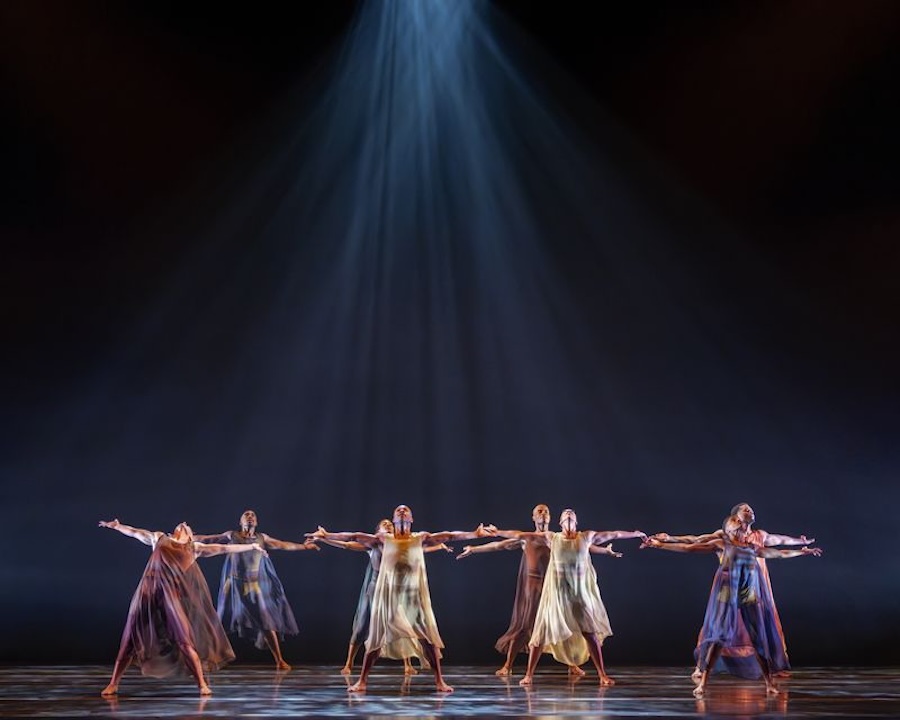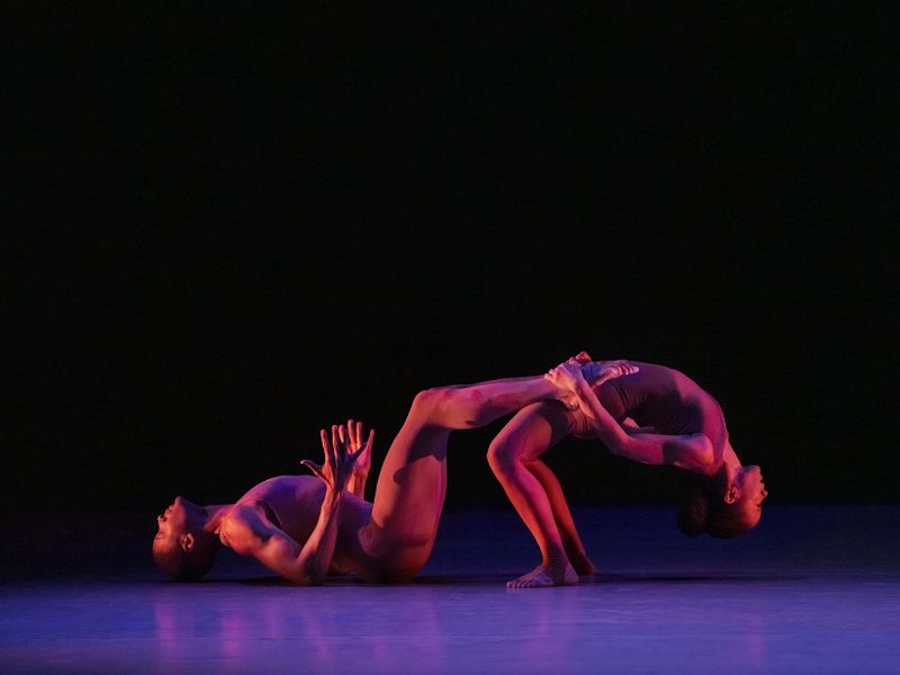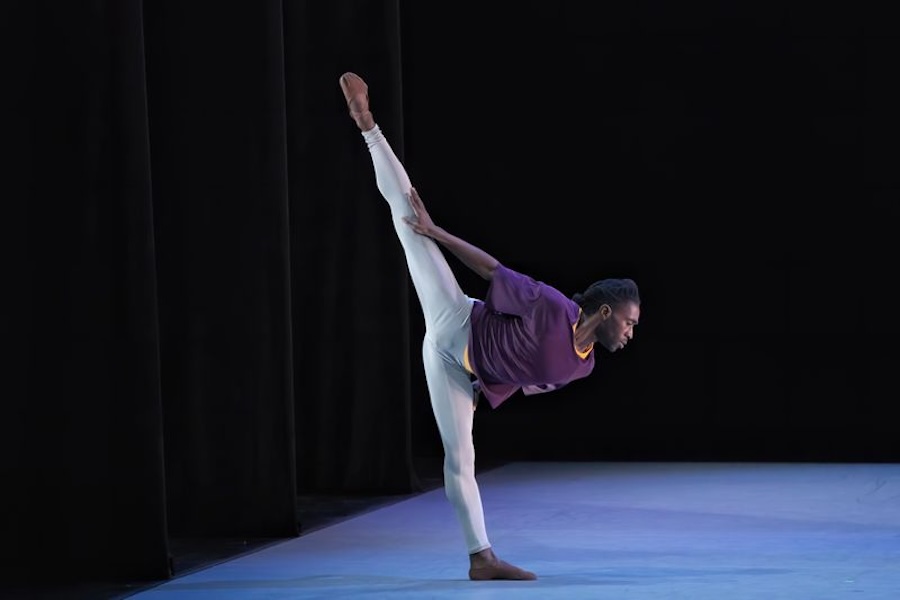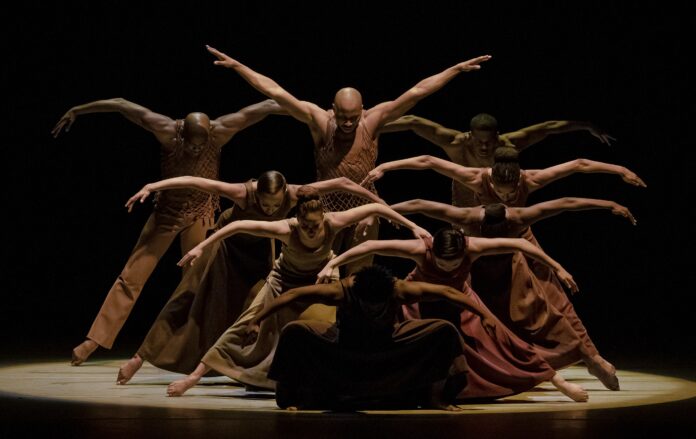Presented by Cal Performances at Zellerbach Hall, April 8-13, the venerable yet still very much alive Alvin Ailey American Dance Theatre placed a forever stamp—one hopes this lasts forever—on the company’s 57 years of annual appearances on the UC Berkeley campus. Four different programs, each worthy of heartfelt applause, included favorite works, premieres, and Ailey’s timeless 1975 “Revelations,” showed off the consistent artistry and rigorous technique of the dancers. Given the company’s 67-year history, a dedication to classic authenticity, and the energetic pursuit of change with the arrival of a new generation of dancers, choreographers, and musicians, those qualities still endure and endear.
This year, the company founded by Ailey in 1958 dedicated the entire 2024-25 season to legendary member Judith Jamison (1943-2024). Jamison was hired as a dancer by Ailey in 1965 and became a signature figure in the field of dance before stepping away in 1980. She returned at Ailey’s request in 1988 to serve as artistic associate. After he died in 1989, Jamison became the company’s second artistic director. Later departing after 21 years, Jamison handed the leadership role to choreographer Robert Battle in 2011, who left the position in 2023 due to health issues. Longtime dancer-choreographer Matthew Rushing, trained in the Ailey school and a dancer with Ailey II before joining the main company in 1992, currently serves as Interim Artistic Director.
The West Coast tour heavily promoted Rushing’s Sacred Songs, a work centered on spirituals that were included in the original 1960 version of Revelations and later cut, primarily for touring purposes. In interviews, Rushing has avoided calling it a prequel, sequel, or other time-pinned descriptor. Instead, he has focused on echoing and connecting the dance and musical styles of what could be called the “mother” work to a new, younger sibling-like piece that speaks to younger generations.
Other highlighted works on the tour included Jamar Roberts’s Al-Andalus Blues, set to Roberta Flack’s “Angelitos Negros” and Miles Davis’s “Sketches of Spain,” Lar Lubovitch’s Many Angels (which floated in on the ethereal Adagietto from Gustav Mahler’s Symphony No. 5), and Ronald K. Brown’s Grace, appearing with fresh vigor in a new 25th-anniversary production.
The final Sunday matinee during the six-day Bay Area run presented works by four different choreographers. Opening was former (and unforgettable) Ailey dancer Hope Boykin’s Finding Free, a complex, odyssey-like work created in collaboration with jazz pianist Matthew Whitaker. After the first intermission, audiences were treated to two gems: Elisa Monte’s Treading, an enthralling duet set to “Eighteen Musicians” by minimalist composer Steve Reich, and Dutch choreographer Hans van Manen’s Solo, a dazzling display pairing music by Johann Sebastian Bach with a trio of superb male dancers who appear to “compete” for who can be most astonishing. Revelation, as tradition has had it, closed the show on a high note that never, ever gets old.

In Finding Free, Boykin’s partnerships with Whitaker and costume designer Jon Taylor began the work with notable visual gravitas and sonic intrigue. The mildly narrative work explores human struggle for freedom throughout the ages and realms of consciousness. As golden side light illuminated the ensemble’s high-collared tightly-belted cloaks—from behind, it looked as if mountain goat horns emerged from their ears and descended to their shoulders—the movement and music were filled with hesitations, interruptions, aborted gestures, silences. It was an eery world of shifting stops, starts, suggested surveillance, and almost-somethings.
The second section, pumped with lush movement and breath, revolved and spun its way into the contrast of third realm. The dance became ritualistic, like a right of passage that was forded only to land incarcerated in prison-like grids and boxes of light cast from above. The sense of surveillance had returned and isolation amped up when a solo dancer twisted and lunged while held in long cloth chains whose offstage holders were unseeable. Breaking free, gathering chains in a bundle, the soloist’s exit introduced the final section. Dancers in gauzy over-garments expressed found freedom with broader movements and more open group formations while accompanied by Whitaker’s organ-like contemporary score that recalled hymnal or praise music.
Finding Free is an ambitious journey and for this viewer, Boykin’s work presented a too-steep entry point, both into the dance itself and into the show. It was rather like trying to enter a house with no front door through an-upper floor window and minus a ladder. Lacking Spiderman capabilities or a catapult, feeling “at home” in Finding Free’s rich themes, emotional resonance, and intricate interplay of individual and communal identity might have benefited from an easier on-ramp. Having taken that position, it is important to acknowledge the very real dilemmas of program order, especially for mixed repertory dance and music performances. (More on that later.)

The Ailey company displayed some of its finest feathers in the afternoon’s next two works. Monte’s Treading had dancers Ashley Kayllynn Green and Christopher Taylor emerging out of a primordial gloom and following a mesmerizing metamorphosis. Like underwater beings rising to earth and perambulating, they morphed into Adam and Eve coupling without the religious or moralistic overtones. It was sensual, gravity-defying, or ground-hugging at any given moment. Molten in every movement, Green and Taylor appeared to discover their own skins—and then each other’s and who or what they might be together.
Van Manen’s “Solo” was created in 1997 for the highly-contrasting, aesthetically more abstractionist Nederlands Dans Theater. Ailey’s three extraordinary dancers presented a stunning, virtuoso rendition displaying impeccable classical ballet technique—piqué turns, emboités, bourrées, and more. Packaged comfortably in robin’s egg blue tights and loose tunics, the dancers’ movement vocabulary incorporated ballet with modern, street, and folk dance and everyday gestures such as shrugs and finger-pointing. Adding cream to the cake was Bach’s lively violin partita and the dancers’ astute comic timing. Christopher Wilson, James Gilmer, and Shawn Cusseaux had the audience laughing, jaws dropped at their individual brilliance, and arguably, cheering for all of them to be declared “winners” at the end of the triple showdown.

By the time Revelations rolled onto the stage, the audience behaved more like members of a royal domain than mere observers of its riches. Ailey’s iconic work has lasted for a reason, multiple reasons in fact. The music is marvelous, the efficiency of getting to the point and having it be a point that matters, and dancer bodies that trace a magnificent trajectory through life’s struggles, travails, joys, and ecstasies is rarely experienced with economy but unlimited grace. Every section had total buy-in from the audiences as dancers either complete or growing in their command of the repertoire completely owned their roles as guardians and shepherds of the Ailey legacy.
During the final curtain calls and as the traditional encore of part of “Rocka My Soul” played out, a surprising thought (a punster might call it a revelation) emerged. Given that program order and ballast was challenged by Boykin’s work in Program C, could the performance have opened more effectively with any of the other works? Would an Ailey show ever open with Revelations? (Traditionalists cry sacrilege worldwide at the mere question.) The question and answer are less important than what they represent: the same kind of freedom from convention found in Program C and its four choreographers and gifted to every person in that concert hall. Imagine a world of your making and, like Ailey, move, members, move.




